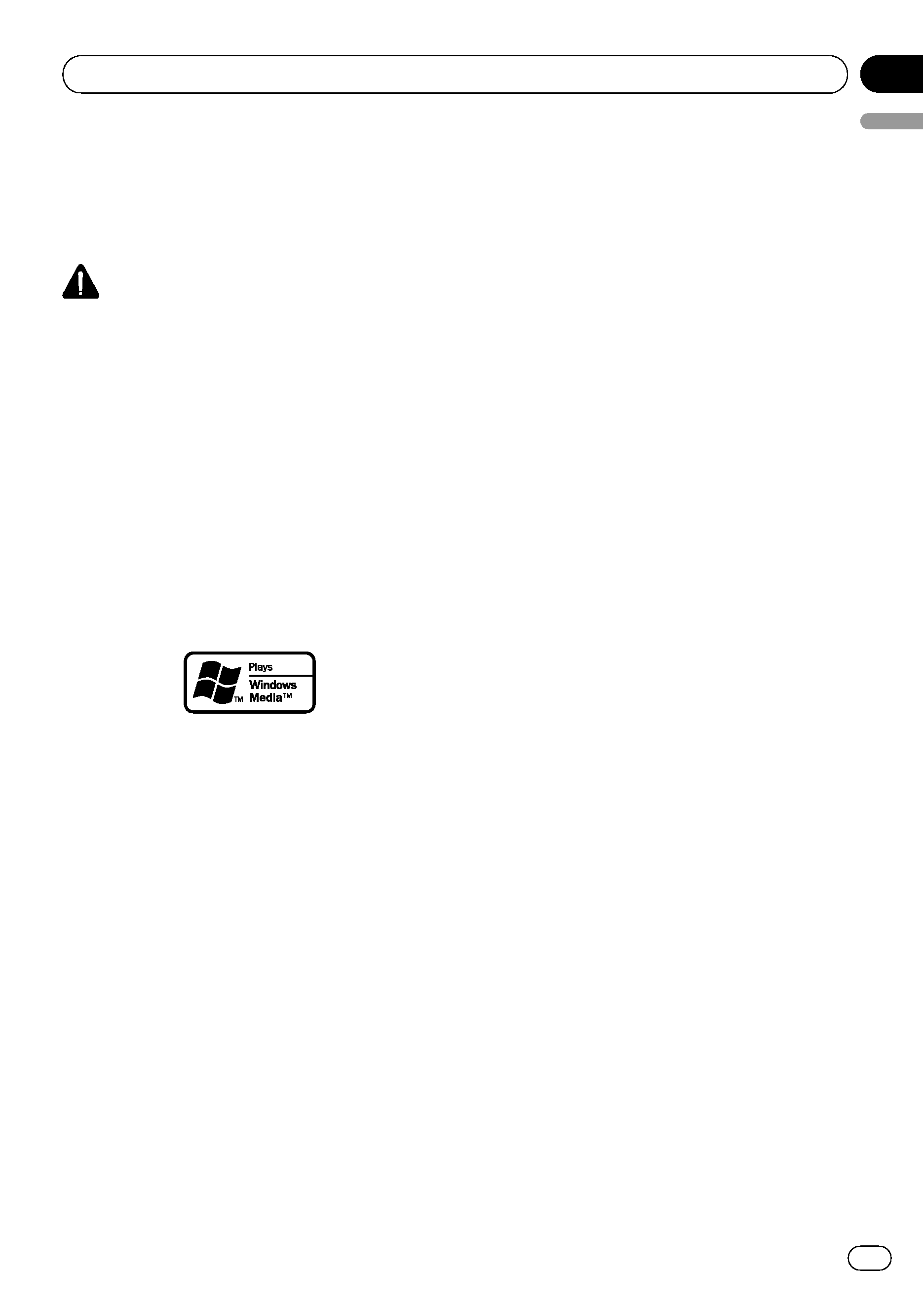
Operation Manual
CD RECEIVER
DEH-P4050UB
English
P
o
rtu
guês
(B)
Español

Thank you for buying this Pioneer product.
Please read through these operating instructions so you will know how to operate
your model properly. After you have finished reading the instructions, keep this man-
ual in a safe place for future reference.
Before You Start
About this unit
5
Visit our website
6
Protecting your unit from theft
6
Removing the front panel 6
Attaching the front panel 6
About the demo mode
7
Use and care of the remote control
7
Installing the battery 7
Using the remote control 7
Operating this unit
What
's What 8
Head unit 8
Remote control 9
Display indication 9
Basic Operations
10
Power ON/OFF 10
Selecting a source 10
Adjusting the volume 11
Tuner
11
Basic Operations 11
Storing and recalling broadcast
frequencies
11
Introduction of advanced
operations
12
Storing the strongest broadcast
frequencies
12
Tuning in strong signals 12
Built-in CD Player
13
Basic Operations 13
Displaying text information on disc 13
Selecting tracks from the track title
list
14
Selecting files from the file name
list
14
Introduction of advanced
operations
15
Selecting a repeat play range 15
Playing tracks in random order 15
Scanning folders and tracks 15
Pausing playback 15
Using Sound Retriever 16
Using disc title functions 16
Playing songs on USB portable audio player/
USB memory
17
Basic Operations 17
Displaying text information of an audio
file
17
Selecting files from the file name
list
17
Introduction of advanced
operations
17
Playing songs on iPod
19
Basic Operations 19
Browsing for a song 19
Displaying text information on
iPod
19
Introduction of advanced
operations
20
Playing songs in a random order
(shuffle)
20
Playing all songs in a random order
(shuffle all)
21
Selecting songs from album list of
currently playing artist
21
Operating this unit's iPod function
from your iPod
21
Changing audiobook speed 21
Audio Adjustments
Introduction of audio adjustments
22
Using balance adjustment
22
Using the equalizer
22
Recalling equalizer curves 22
Adjusting equalizer curves 23
Fine-adjusting equalizer curve 23
Adjusting loudness
24
Using subwoofer output
24
Contents
En
2

Adjusting subwoofer settings 24
Using the high pass filter
25
Boosting the bass
25
Adjusting source levels
25
Initial Settings
Adjusting initial settings
26
Setting the clock
26
Setting the FM tuning step
26
Setting the AM tuning step
26
Switching the warning tone
27
Switching the auxiliary setting
27
Switching the dimmer setting
27
Setting the rear output and subwoofer
controller
27
Switching the feature demo
28
Switching the Ever Scroll
28
Activating the BT AUDIO source
28
Entering PIN code for Bluetooth wireless
connection
28
Displaying system version of Bluetooth
adapter for repair
29
Other Functions
Using the AUX source
30
About AUX1 and AUX2 30
AUX1 source: 30
AUX2 source: 30
Selecting AUX as the source 30
Setting the AUX title 30
Turning the clock display on or off
30
Using the external unit
31
Selecting the external unit as the
source
31
Basic operation 31
Using the functions allocated to 1 to 6
keys
31
Advanced operations 31
Available accessories
Playing songs on iPod
32
Basic operation 32
Displaying text information on
iPod
32
Browsing for a song 32
Function and operation 32
Playing songs in a random order
(shuffle)
33
Bluetooth Audio
33
Basic Operations 33
Function and operation 33
Connecting a Bluetooth audio
player
34
Playing songs on Bluetooth audio
player
34
Stopping playback 34
Disconnecting a Bluetooth audio
player
34
Displaying BD (Bluetooth Device)
address
35
Bluetooth Telephone
35
Basic Operations 35
Setting up for hands-free phoning 35
Making a phone call 36
Taking a phone call 36
Introduction of advanced
operations
36
Connecting a cellular phone 37
Disconnecting a cellular phone 38
Registering a connected cellular
phone
38
Deleting a registered phone 38
Connecting to a registered cellular
phone
38
Using the Phone Book 39
Using the Call History 40
Making a call by entering phone
number
40
En
3
English
Contents

Clearing memory 40
Setting automatic rejecting 41
Setting automatic answering 41
Switching the ring tone 41
Echo canceling and noise
reduction
41
Multi-CD Player
41
Basic Operations 41
Using CD TEXT functions 41
Introduction of advanced
operations
41
Using compression and bass
emphasis
42
Using ITS playlists 43
Using disc title functions 44
TV tuner
44
Basic Operations 44
Storing and recalling broadcast
stations
45
Storing the strongest broadcast
stations sequentially
45
Additional Information
Error messages
46
Handling guideline of discs and player
47
Dual Discs
48
Compressed audio compatibility
48
USB audio player/USB memory
48
USB audio player/USB memory
compatibility
48
USB audio player/USB memory 49
Compressed audio compatibility 50
iPod
50
About handling the iPod 50
About iPod settings 50
Compressed audio files on the disc
51
Example of a hierarchy 51
Specifications
52
Contents
En
4

About this unit
CAUTION
! Do not allow this unit to come into contact
with liquids. Electrical shock could result.
Also, damage to this unit, smoke, and over-
heating could result from contact with liquids.
! Keep this manual handy as a reference for op-
erating procedures and precautions.
! Always keep the volume low enough so that
you can hear sounds from outside the vehicle.
! Protect this unit from moisture.
! If the battery is disconnected or discharged,
the preset memory will be erased and must be
reprogrammed.
About WMA
The Windows Media
TM logo printed on the box
indicates that this unit can play back WMA
data.
Windows Media and the Windows logo are tra-
demarks or registered trademarks of Microsoft
Corporation in the United States and/or other
countries.
! This unit may not operate correctly depend-
ing on the application used to encode
WMA files.
About MP3
Supply of this product only conveys a license
for private, non-commercial use and does not
convey a license nor imply any right to use
this product in any commercial (i.e. revenue-
generating) real time broadcasting (terrestrial,
satellite, cable and/or any other media), broad-
casting/streaming via internet, intranets and/
or other networks or in other electronic con-
tent distribution systems, such as pay-audio or
audio-on-demand applications. An indepen-
dent license for such use is required. For de-
tails, please visit
http://www.mp3licensing.com.
About AAC
This unit plays back AAC files encoded by
iTunes®.
iTunes is a registered trademark of Apple Inc.
Portable audio player compatibility
! Inquire at the manufacturer about your
USB portable audio player/USB memory.
This unit corresponds to the following.
-- USB MSC (Mass Storage Class) compliant
portable audio player and memory
-- WMA, MP3, AAC and WAV file playback
For details about the compatibility, refer to
USB audio player/USB memory compatibility
on page 48.
iPod® compatibility
This unit can control and listen to songs on an
iPod.
! This unit can control the following iPod
models.
-- iPod nano
-- iPod fifth generation or later
For maximum performance, we recom-
mend that you use the latest version of the
iPod software.
! When using an iPod, iPod Dock Connector
to USB Cable is required.
! Pioneer CD-IU50 interface cable is also
available. For details, consult your dealer.
! This unit can control previous generations
iPod models with a Pioneer iPod adapter
(e.g. CD-IB100
N). In this case, most func-
tions are essentially the same as an iPod
connected to USB interface of this unit.
However, functions related to Audiobooks
and Podcasts cannot be used.
For details concerning operation with the
iPod adapter, refer to Playing songs on iPod
on page 32.
! iPod is a registered trademark of Apple Inc.
Before You Start
En
5
English
Section
01
